Pallas’s Grasshopper Warbler Helopsaltes certhiola 小蝗鶯
Category I. Common passage migrant in autumn, but scarce in winter and spring; occurs in a variety of planted and natural dense vegetation but is usually associated with wetlands. Three subspecies are considered to occur regularly: certhiola, minor and rubescens.
IDENTIFICATION
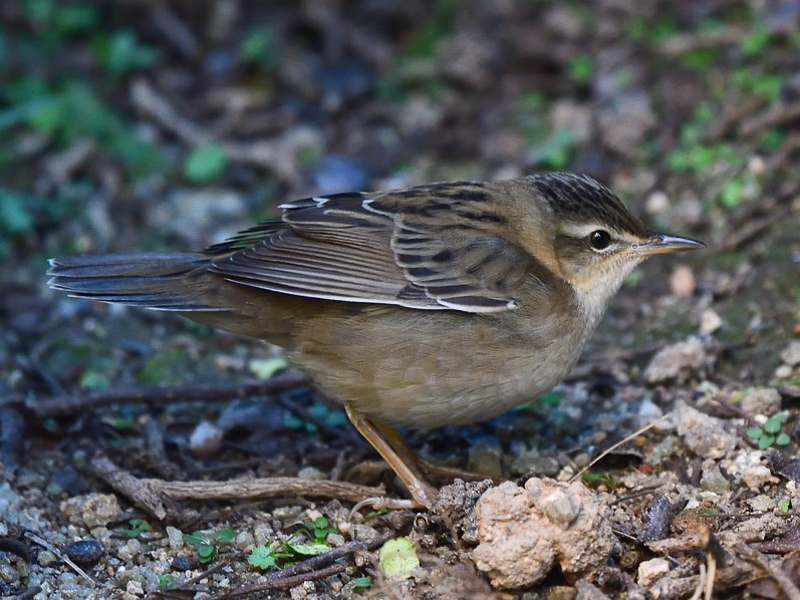
Oct. 2017, Kinni Ho. Adult H. c. minor.
12-14 cm. Typical structure of genus: short neck, round body, long undertail coverts, graduated tail and notably rounded longest outer primary that has a whitish outer web. Has obvious pale supercilium, boldly streaked mantle, warm brown rump and uppertail coverts with dark feather centres and often has pale tips to the tail feathers, though these are usually best seen from below. In flight tail often holds slightly splayed.
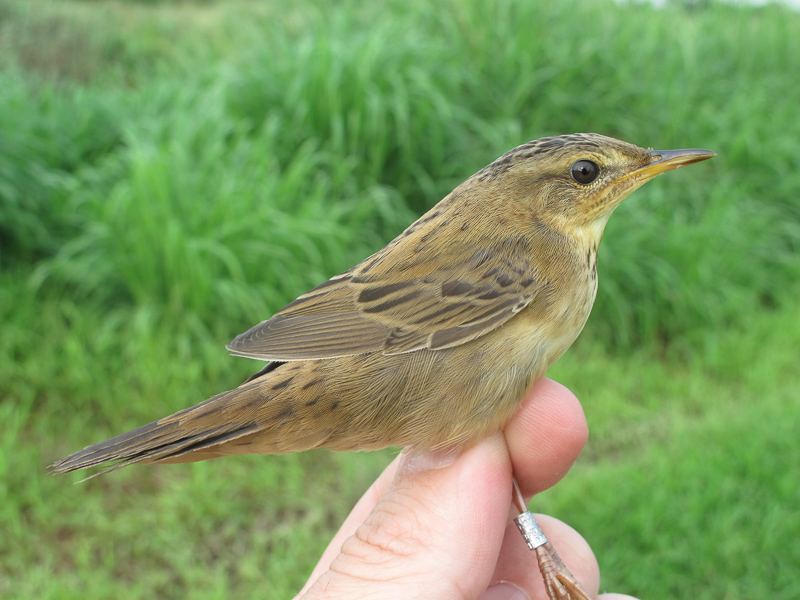
Sep. 2013, Paul Leader. First-winter H. c. certhiola.
First-winter certhiola is generally rather pale and sandy, poorly marked on the mantle and crown, and has sandy fringes to wing coverts. A less conspicuous supercilium and lower throat and chest streaks indicate first-winter plumage.
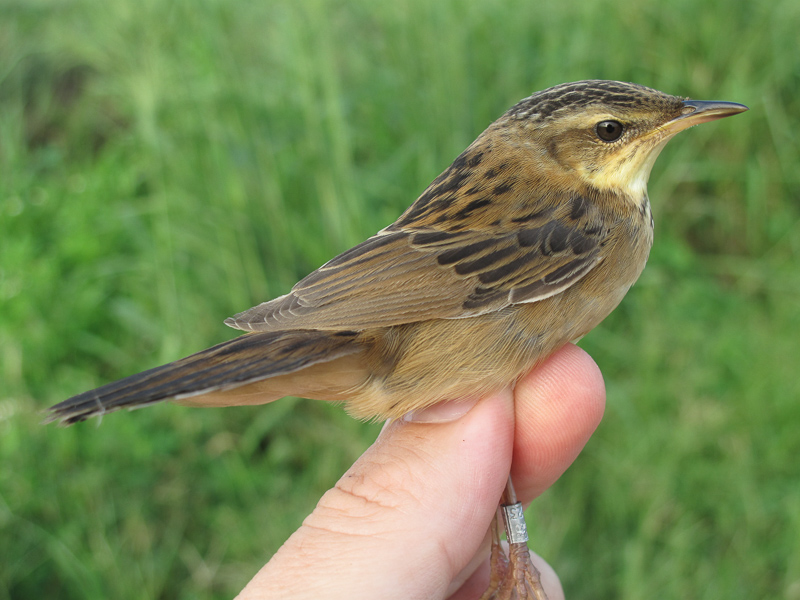
Oct. 2010, Paul Leader. First-winter H. c. minor.
First-winter minor is darker and colder than certhiola, with more heavily streaked crown and mantle, and with darker, less sandy fringes to the wing coverts. Intergrades with certhiola are quite common.
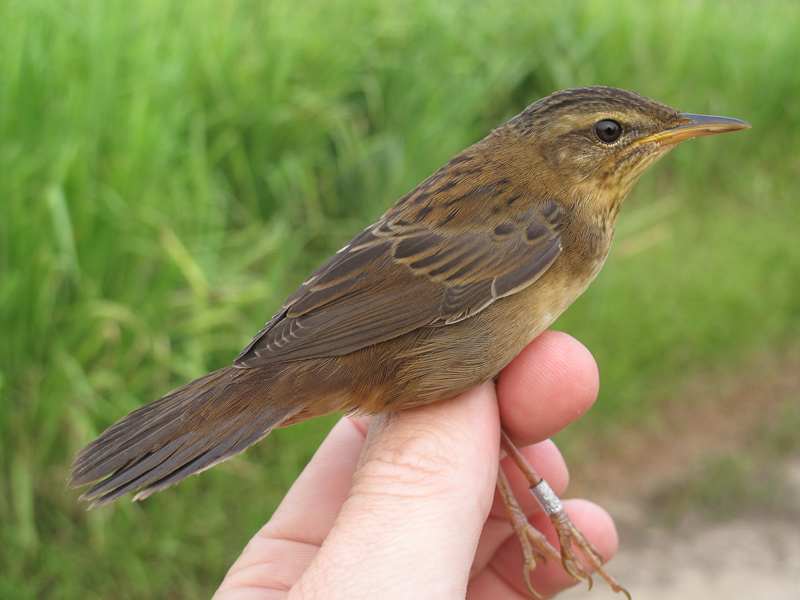
Sep. 2012, Paul Leader. First-winter H. c. rubescens.
First-winter rubescens is larger and darker than both certhiola and minor. Obviously large-billed, it is dark, rather earthy-brown above, usually poorly streaked, especially on the rump and upper tail coverts, resulting in more uniform upperparts. The scarcest of the three taxa, it may easily be confused with Middendorff’s Grasshopper Warbler.
VOCALISATIONS
The call is a hard, at times loud, ‘pwit’.
The alarm call is a distinctive and loud fast rattle that gently descends in pitch.
The song heard here is usually less developed than that on the breeding grounds, though the main constituents and structure are present. Usually heard from reedbed, freshwater marsh or the densely-vegetated edge, often including reeds, of inactive fish ponds.
DISTRIBUTION & HABITAT PREFERENCE
Most records are of birds trapped in the reed marsh at Mai Po NR, but it occurs in a diverse array of habitats on migration from urban parks and landscaped areas through freshwater marsh to abandoned or inactive wet agricultural land. It is largely, however, a species of wetlands.
OCCURRENCE
Pallas’s Grasshopper Warbler is a common passage migrant in autumn but is scarce in winter and spring. Extreme dates are 23 August 2006 and 28 May 2014.
The most systematic dataset available for this species comes from the constant-effort trapping programme in reed marsh at Mai Po from the last week of August to the last week of May during winter periods from 2008/09 to 2020/21 (Figure 1). These data indicate the first birds arrive in the last week of August, with numbers increasing steeply in the first half of September to peak in the third week of the month. Allcock et al. (2013) noted that 84% of trapping records during 2001-2011 occurred in September. There follows an equally steep decline to the second week of October, and then a more gradual decrease to the middle of December. There are occasional records in winter and a weak spring passage in April and May.
Large concentrations can occur in some years, and the highest count is 70, of which 46 were trapped, in the reed marsh at Mai Po NR on 6 September 2013; in addition, 54 were trapped there on 21 September 2016. Away from Mai Po, the highest counts are 55 at Luk Keng on 13 September 1991, 45 at Long Valley on 28 September 1994, with 35 there on 14 September 1997, and 30 at Luk Keng on 17 September 1994. However, the highest count away from Mai Po since 1999 is only 20, at Lok Ma Chau MTRC Ecological Enhancement Area.
Regular trapping in the reedbed at Mai Po NR indicates that turnover is high, with most birds remaining for only a few days. Some birds remain in the reedbed to moult, however, with recaptures including birds that remained for over two months. Re-trapping of individuals in subsequent seasons is rare (Allcock et al. 2013).
BEHAVIOUR, FORAGING & DIET
Skulking, shy and difficult to see. Creeps around on the ground or very low in dense vegetation as it forages for insects. Flicks its wings constantly when alert. When flushed it flies very low over vegetation with its tail spread and the rufous rump often visible before it dives into cover. Regularly utters low-intensity song from late January to the end of spring passage when its willingness to perch more or less in the open is greater.
RANGE & SYSTEMATICS
Five subspecies are recognised across its breeding range, which extends through southwest, south and southeast Siberia and includes east Kazakhstan, Mongolia and north China; it winters in Sri Lanka, northeast India, southeast Asia and the Greater Sundas (Pearson 2021). In China it is a summer visitor to the northwest and northeast (Liu and Chen 2021).
Based on in-hand examination, the subspecies occurring in HK are minor, certhiola and rubescens. Most midwinter birds are the latter.
CONSERVATION STATUS
IUCN: Least Concern. Population trend decreasing.
Figure 1.
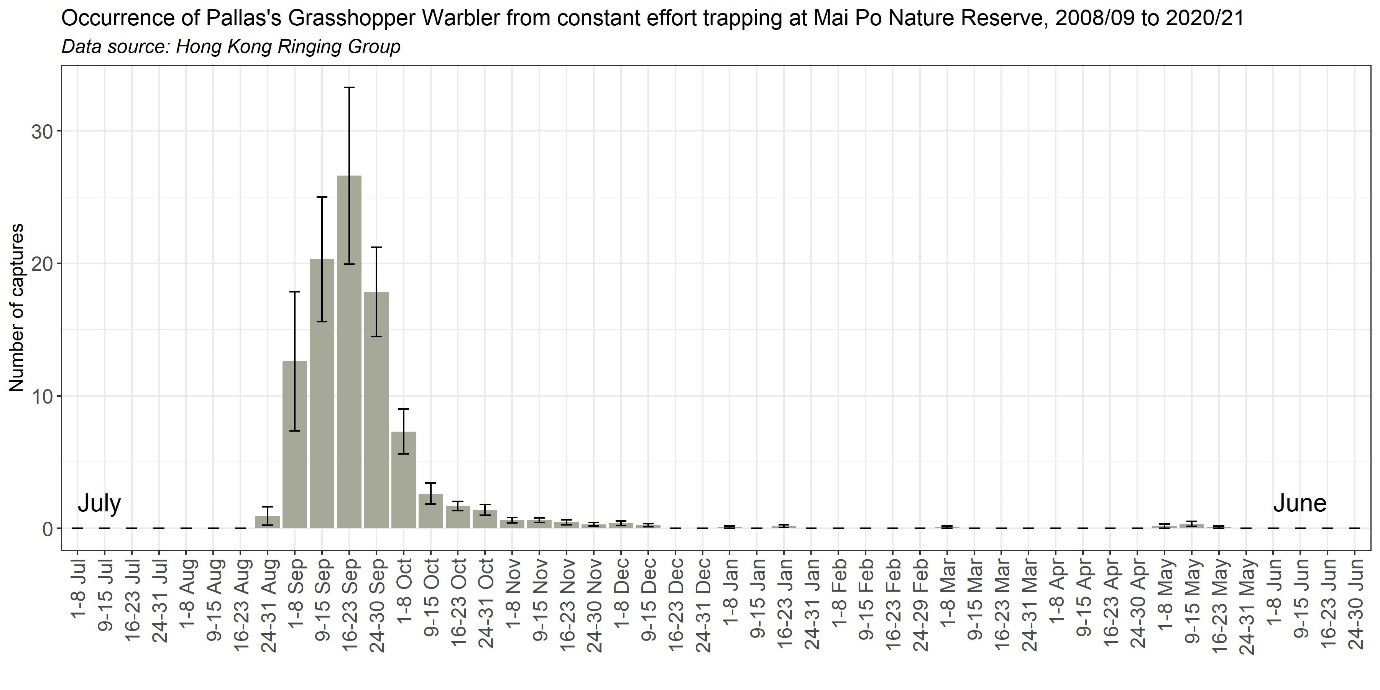
Allcock, J. A., P. J. Leader, M. R. Leven, D. J. Stanton and K. Leung (2013). Seasonality of Acrocephalus and Locustella warblers in the reedbeds at Mai Po Nature Reserve. Hong Kong Bird Report 2011: 234-252.
Liu, Y. and S. H. Chen (eds) (2021). The CNG Field Guide to the Birds of China (in Chinese). Hunan Science and Technology Publication House, Changsha.
Pearson, D. (2021). Pallas's Grasshopper Warbler (Helopsaltes certhiola), version 1.1. In Birds of the World (J. del Hoyo, A. Elliott, J. Sargatal, D. A. Christie, and E. de Juana, Editors). Cornell Lab of Ornithology, Ithaca, NY, USA. https://doi.org/10.2173/bow.pagwar1.01.1.

